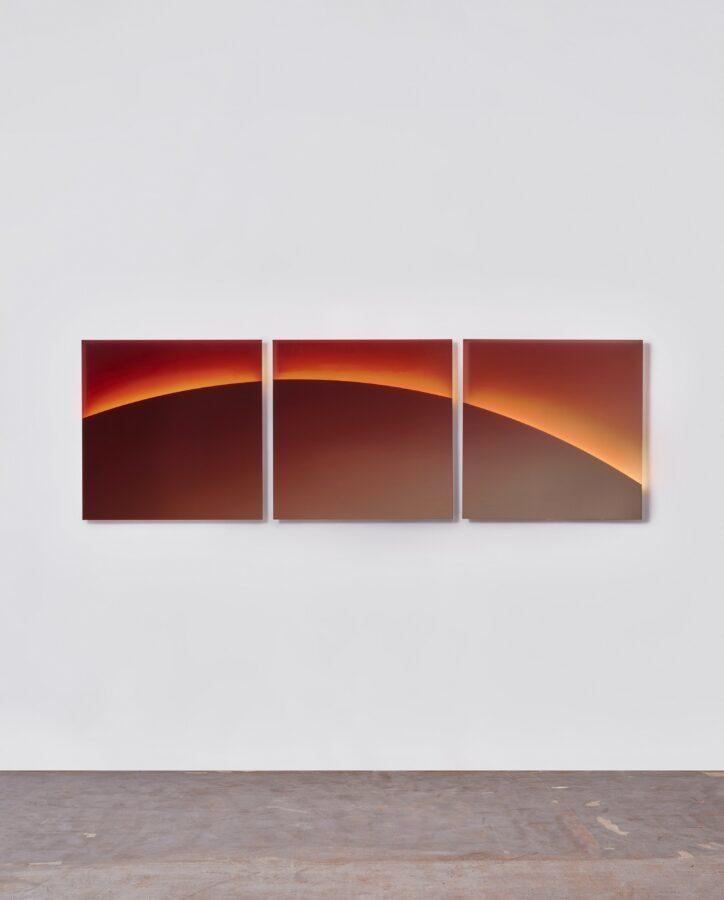With a new lighting collection for IKEA, the Rotterdam-based designer’s distinctive approach to material and colour is very much of the moment
 Photography courtesy of IKEA and Sabine Marcelis featuring her Varmblixt collection
Photography courtesy of IKEA and Sabine Marcelis featuring her Varmblixt collection
Words by Amy Frearson
‘You can really determine how translucent or opaque the material becomes,’ explains designer Sabine Marcelis. We’re standing in a factory space below her Rotterdam studio watching a team of craft makers mix liquid resin with colour pigments, to produce different versions of her signature Candy Cube tables.
Each of these minimal blocks is made to a specific colour recipe that creates a surprising duality; the mass is so richly toned that it appears dense and solid, yet the precise edges offer an ethereal glow that suggests otherwise. The result looks like a giant block of jelly, waiting to be wobbled.
It is this flair for material wizardry that has propelled Marcelis to success. As a self-confessed production nerd who loves watching the Discovery Channel show How It’s Made, Marcelis creates designs with a formal purity that belies the complex processes that go into manufacturing them.
Whether she’s designing a piece of furniture with no visible seams, as she did with her Boa Pouf for Swedish homeware brand Hem, or producing mirrors imbued with gradients of light and colour, as she did with her Mirage collection for Gallery Collectional in Dubai, Marcelis knows how to manipulate a material’s properties to create the unexpected.
 Photography by Rami Mansour featuring Mirage, Dubai Design Week for Gallery Collectional, 2022
Photography by Rami Mansour featuring Mirage, Dubai Design Week for Gallery Collectional, 2022
‘That’s what makes it fun to be a designer,’ she says. ‘I may not be saving people’s lives, but I’m hopefully creating an emotional response, an experience and a curiosity.’
Marcelis wasn’t always aware of this talent. Having grown up in New Zealand, she had aimed for a career as a professional snowboarder for several years before deciding she needed a new direction. After studying for a bachelor’s degree in design – initially at Victoria Design School in Wellington, then at Design Academy Eindhoven – one of her first jobs was assisting Danish artist FOS to create interiors for French fashion house Céline.
It was here that Marcelis began to realise that, unlike many other designers, she had both the vision and the technical knowhow for turning abstract concepts into reality. This made her an ideal fit for the fashion world and its endless pursuit of perfection, so it wasn’t long before she was winning commissions of her own, from the likes of Fendi, Burberry and, most recently, Dior.
 Photography courtesy of IKEA featuring the Varmblixt collection
Photography courtesy of IKEA featuring the Varmblixt collection
Like any designer, commercial products play an important role in Marcelis’ output. Alongside partnerships with brands including Established & Sons, Natuzzi and CC-Tapis, she has also been working on a major collaboration with IKEA: she has designed an entire collection of lights called Varmblixt, which is rolled out in stores this month.
However, Marcelis is cautious about working on projects that might compromise the visual clarity that underpins her approach. ‘I’m being very careful with that world,’ she says. Her preference, she tells me, is limited-edition objects and installations, like her reimagining of the Barcelona Pavilion in 2019, or her large-scale brutalism-inspired piece at last year’s London Design Festival.
It would be easy to assume that colour is the driving force behind Marcelis’ work, particularly if you’ve visited her installation at the Vitra Design Museum, for which she has reorganised the 400 exhibits in the Vitra Schaudepot gallery in a rainbow effect that brings to mind a hipster’s bookshelf. Yet, dressed head-to-toe in black, she insists this is not the case. ‘I’m not a colourful person,’ she says, ‘but in my work it’s a design tool, because particular colours can create different effects and certain moods.’
 Photography by Mark Niedermann featuring Sabine Marcelis, Colour Rush! at the Vitra Design Museum
Photography by Mark Niedermann featuring Sabine Marcelis, Colour Rush! at the Vitra Design Museum
Marcelis’ main interest lies in the qualities of light and transparency, and the materials that best help her achieve them. This is why she loves glass and resin, she explains. ‘These are the materials with the widest range of possibilities,’ she says. ‘They can be completely transparent or opaque; they can be super shiny and reflective, or quite the opposite.’
The designer loves to experiment with new materials, as she did in her collaboration with natural stone company SolidNature, which saw her create an angular, monolithic bathroom using slabs of pale pink onyx at Alcova during Milan Design Week 2022. However, she isn’t one for sketching out her concepts, preferring instead to tackle things hands-on. ‘I am embarrassingly bad at drawing,’ she says.
In each project, Marcelis hopes to build on what she has learned before to create even more extreme possibilities. The resin techniques she developed for the Candy Cubes back in 2014 have since evolved into far more complex forms, like the graffiti-defying ribbon artwork she created for the Miss Dior perfume, made by shaping a single length of heated resin, or the huge, curved planes that form the legs of her SOAP Table.
‘I’m always building on older projects, while also observing things in nature, to help me see what might be possible next,’ she says. Whatever that is, Marcelis is up to the challenge.
The original version of this article appeared in ICON 209. Get a curated collection of architecture and design news like this in your inbox by signing up to our ICON Weekly newsletter
















